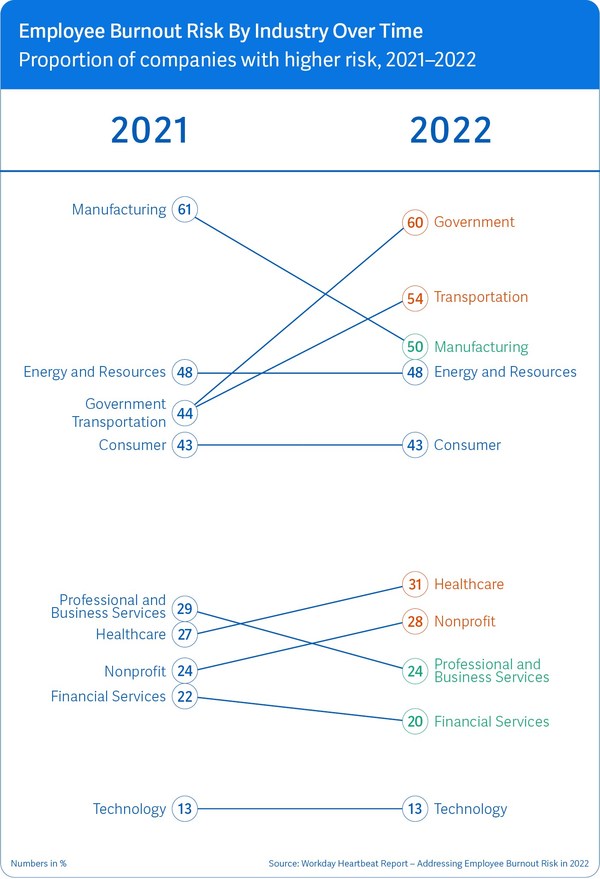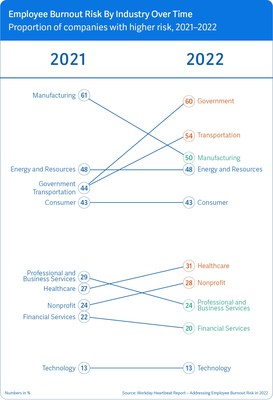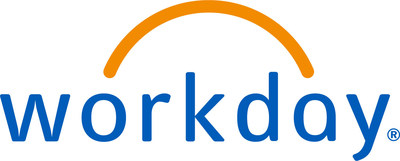Transportation Industry Sees Greatest Increase in Scale of Higher Burnout Risk
PLEASANTON, Calif. and ORLANDO, Fla., Sept. 12, 2022 /PRNewswire/ -- Workday (NASDAQ:WDAY), a leader in enterprise cloud applications for finance and human resources, today published a new report – Addressing Burnout Risk in 2022 – powered by employee engagement solution Workday Peakon Employee Voice. The report finds that, of the 10 industries tracked year-over-year, frontline industries such as transportation, healthcare, and government demonstrated increases in the levels of higher burnout risk, with the transportation industry showing the steepest rise of 16% since 2021. In addition, of the 10 geographies tracked year-over-year, the UK has become the country with the highest proportion of organizations (41%) in the higher burnout risk category. Meanwhile, the proportion of U.S.-headquartered companies with higher burnout risk remained at 17%.
The report, launched at Workday Rising, the company's annual customer conference, measures how burnout risk has evolved since 2021 across different industries and geographies, based on an analysis of de-identified employee survey data from 1.5 million employees from more than 600 companies around the world. Burnout risk is assessed using employee survey scores relating to connectedness, energy levels, and fulfillment, and then categorized as higher, medium, or lower risk.
Burnout Risk by Industry
The study found that the majority of surveyed industries saw greater or sustained levels of higher burnout risk in 2022, compared to 2021. Industries that operated on the front lines of the pandemic, such as transportation, government, and healthcare, saw the steepest increases year-over-year, whereas manufacturing, professional and business services, and financial services saw reduced levels of higher burnout risk.
- Increasing Risk
- Transportation: Following a steep 16% year-over-year increase, 60% of surveyed transportation companies fell into the higher risk category in 2022.
- Government: The government industry also saw a significant (10%) increase in the proportion of companies with higher burnout risk, rising to 54%.
- Healthcare: The proportion of healthcare companies in the higher burnout risk category rose to 31% year-over-year, following a rise of 4%.
- Non-Profit: The non-profit industry saw the proportion of companies in the higher burnout risk category increase by 4% to 28%.
- Holding Steady
- Technology: The technology sector held steady year-over-year, with just 13% of organizations in the higher burnout risk category – the lowest proportion of the industries tracked over time.
- Consumer: The consumer industry held steady at 43%.
- Energy and Resources: The energy and resources industry held steady at 48%.
- Decreasing Risk
- Manufacturing: While still showing high levels of burnout risk, the manufacturing industry saw an 11% year-over-year reduction in the proportion of organizations with higher burnout risk to 50%.
- Professional and Business Services: Professional and business services saw a 5% reduction in organizations with higher burnout risk to 24%.
- Financial Services: Financial services enjoyed a 2% drop to 20%.
Burnout Risk by Geography
The report found global variation among the 10 geographies tracked year-over-year, with six seeing either increased or sustained levels of higher burnout risk, and four showing improvements.
- Increasing Risk
- UK: UK-headquartered companies currently have the highest proportion of organizations in the higher burnout risk category – 41%, following a year-over-year rise of 4%.
- Norway: Norway saw a 9% year-over-year increase to 20%.
- Canada: Canada, while still registering comparatively low levels of higher burnout risk, saw a 3% increase to 12%.
- Denmark: Denmark registered the lowest levels of higher burnout risk, but did see a 3% rise year-over-year to 11%.
- Holding Steady
- U.S.: The proportion of U.S.-headquartered organizations in the higher burnout risk category held steady at 17% year-over-year.
- New Zealand: Like the U.S., New Zealand saw the same levels of higher burnout risk year-over-year – 28%.
- Decreasing Risk
- Australia: Australia-based companies saw a sharp 19% reduction in the proportion of organizations with higher burnout risk year-over-year to 22%.
- Germany: Germany-based companies saw a 15% reduction in the proportion of organizations with higher burnout risk to 26%.
- France: France-based companies saw a 7% reduction in the proportion of organizations with higher burnout risk to 39%.
- The Netherlands: The Netherlands also saw a year-over-year reduction of 5% to 33%.
The issue of employee burnout is increasingly prevalent, with a 2021 survey, conducted by the American Psychological Association, finding that three in five employees reported negative impacts of work-related stress. However, as the Workday report explores, there are key actions employers can take, powered by intelligent listening, to help mitigate the risk of employee burnout. These include:
- Cultivating a more compassionate culture by building transparency around the issue of wellbeing and strengthening workplace policies to support it.
- Enabling people leaders to solve problems by encouraging open dialogues on workload, workplace fulfillment, and the impact of their contributions.
- Giving employees a shared sense of purpose by clearly articulating the organization's strategy and how new ideas speak to that vision.
Comment On The News
"The increasing levels of higher burnout risk in frontline industries like government, healthcare, and transportation reflects an urgent need to address the energy, connectedness, and fulfillment levels of employees," said Phil Chambers, general manager, of Workday Peakon Employee Voice, Workday. "From the Great Resignation to the more recent wave of quiet quitting, it is vital that leaders understand employees' evolving needs and take positive action to help keep them engaged, motivated, and meet them in the moment."
For more information:
- Download the report, "Addressing Burnout Risk in 2022"
- Read the blog, "How Rising Rates of Burnout Risk Are Impacting Different Industries in 2022"
About Workday
Workday is a leading provider of enterprise cloud applications for finance and human resources, helping customers adapt and thrive in a changing world. Workday applications for financial management, human resources, planning, spend management, and analytics have been adopted by thousands of organizations around the world and across industries – from medium-sized businesses to more than 50% of the Fortune 500. For more information about Workday, visit workday.com.
© 2022 Workday, Inc. All rights reserved. Workday and the Workday logo are registered trademarks of Workday, Inc. All other brand and product names are trademarks or registered trademarks of their respective holders.
Forward Looking Statements:
This press release contains forward-looking statements including, among other things, statements regarding Workday's plans, beliefs, and expectations. These forward-looking statements are based only on currently available information and our current beliefs, expectations, and assumptions. Because forward-looking statements relate to the future, they are subject to inherent risks, uncertainties, assumptions, and changes in circumstances that are difficult to predict and many of which are outside of our control. If the risks materialize, assumptions prove incorrect, or we experience unexpected changes in circumstances, actual results could differ materially from the results implied by these forward-looking statements, and therefore you should not rely on any forward-looking statements. Risks include, but are not limited to, risks described in our filings with the Securities and Exchange Commission ("SEC"), including our Form 10-Q for the fiscal quarter ended July 31, 2022, and our future reports that we may file with the SEC from time to time, which could cause actual results to vary from expectations. Workday assumes no obligation to, and does not currently intend to, update any such forward-looking statements after the date of this release.
Any unreleased services, features, or functions referenced in this document, our website, or other press releases or public statements that are not currently available are subject to change at Workday's discretion and may not be delivered as planned or at all. Customers who purchase Workday services should make their purchase decisions based upon services, features, and functions that are currently available.
SOURCE Workday Inc.



